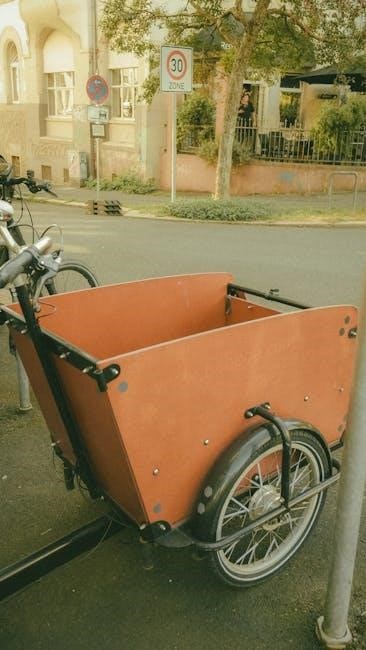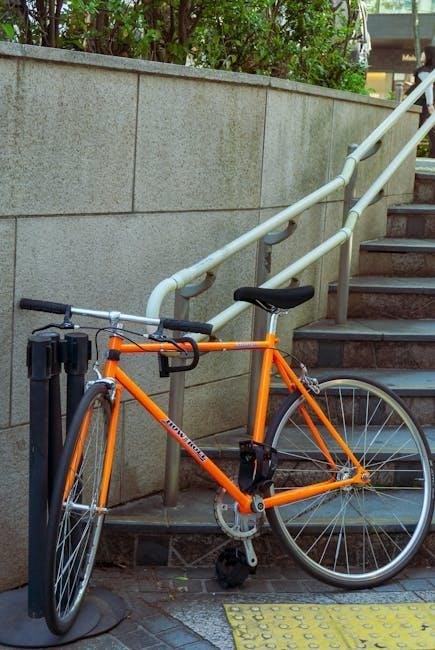The Saris bicycle rack offers a reliable and efficient way to transport bikes, blending innovation with ease of use. Its modular design and sturdy construction ensure a secure fit for various vehicles, making it a top choice for cyclists seeking convenience and safety on the go.

Components of a Saris Bicycle Rack
A Saris bicycle rack typically includes a sturdy mainframe, hitch assembly, bike trays, securing straps, and anti-sway mechanisms. Some models feature modular designs, allowing for future upgrades and compatibility with various bike styles and vehicle setups.
Key Hardware and Tools Needed
Installing a Saris bicycle rack requires specific hardware and tools to ensure a secure and proper setup. Begin with an Allen wrench (commonly 3mm or 5mm) for assembling the rack’s components. A wrench or ratchet is necessary for tightening bolts and securing the rack to the vehicle’s hitch. A torque wrench is recommended to apply the correct torque as specified in the manual, ensuring a stable connection. The rack typically includes a hitch pin or bolt to attach it to the vehicle’s hitch receiver. Additionally, securing straps or cables are essential for holding the bikes in place, and may require tightening with a wrench or ratchet. For moving parts, silicone spray or grease can be used to lubricate hinges and joints, preventing rust and ensuring smooth operation. Finally, always refer to the user manual for exact specifications and guidance tailored to your Saris model, as improper installation can lead to safety hazards. Having these tools and hardware ready will streamline the installation process and ensure your rack is safely and correctly mounted.

Understanding the Hitch System
The hitch system is a critical component of the Saris bicycle rack, designed to securely attach the rack to your vehicle. Most Saris racks are compatible with standard 1.25-inch or 2-inch hitch receivers, ensuring versatility across various vehicles. The hitch system typically includes a hitch pin or locking mechanism to prevent theft and ensure stability. Proper alignment and tightening of the hitch pin are essential to avoid wobbling or movement during transit. The Saris Fit Guide provides specific recommendations for your vehicle, ensuring the rack is compatible and safely installed. Weight capacity varies by model, but most Saris racks support between 100 to 220 pounds, depending on the design. Always check the manual for your model’s specifications to ensure you do not exceed the weight limit. A secure hitch connection is vital for safety, as it prevents the rack from shifting and potentially damaging your vehicle or bicycles. Regularly inspect the hitch system for wear and tighten as needed to maintain a safe and reliable setup.

Safety Precautions
Always follow safety guidelines to protect your vehicle and bicycles. Adhere to the Saris Fit Guide and never exceed weight limits. Inspect the rack for loose parts before use. Avoid overloading to prevent damage or accidents during transit.
Importance of the Saris Fit Guide
The Saris Fit Guide is a crucial tool for ensuring compatibility between your vehicle and the bicycle rack. It provides detailed information about the correct installation and compatibility, helping to prevent improper mounting that could lead to safety issues. By following the Fit Guide, you ensure that your Saris bicycle rack is securely attached to your vehicle, reducing the risk of damage to both the rack and your car. Additionally, the Fit Guide helps maximize the performance of the rack, ensuring that it functions as intended. Regularly updating your Fit Guide knowledge is essential to keep up with any new models or changes. Overall, the Saris Fit Guide is your go-to resource for a safe and efficient setup, making it indispensable for all Saris rack users.

Installation Process
The installation of a Saris bicycle rack involves assembling the unit, attaching it to your vehicle’s hitch, and securing it firmly. Follow the step-by-step guide for a safe and proper setup.
Step-by-Step Installation Guide
Begin by unpacking and inventorying all components, ensuring no parts are missing. Assemble the rack according to the provided instructions, carefully attaching the arms and trays. Next, locate your vehicle’s hitch receiver and insert the rack’s hitch pin, securing it tightly. Adjust the rack to fit your vehicle’s height and level it properly. Tighten all bolts and screws to ensure stability. Finally, test the rack by gently rocking it to confirm it’s secure. Always refer to the Saris Fit Guide to ensure compatibility with your vehicle and bike type.

Loading Your Bicycles

Position your bicycle onto the rack’s tray, ensuring the wheels are securely held by the wheel straps. Tighten the frame clamp around the bike’s frame to hold it in place. Repeat for additional bikes, checking weight limits and ensuring even distribution. Secure all straps firmly to prevent movement during transit.

Proper Securing Techniques

Securing your bicycles to a Saris rack is crucial for safe transport. Start by positioning the bike on the rack, ensuring the wheels align with the wheel holders. Use the provided straps to secure the wheels, tightening them firmly to prevent movement. For the frame, attach the frame clamp or hook, ensuring it rests on a sturdy part of the bike, such as the top tube. Avoid overtightening to prevent damage. For added stability, use any additional straps or ties provided, especially for components like handlebars or pedals. Always check the Saris Fit Guide to ensure compatibility and adhere to weight limits. Finally, perform a final inspection, tugging gently on the bikes to ensure they are securely fastened before driving. Proper securing techniques protect both your bikes and your vehicle during transit.
Troubleshooting Common Issues
Common issues include loose connections, bikes shifting during transit, or parts not fitting. Ensure proper assembly, check the Saris Fit Guide for compatibility, and consult the manual for solutions to specific problems or maintenance needs.
Solutions and Maintenance Tips
For common issues like loose connections or bikes shifting during transit, ensure all hardware is securely tightened and double-check the assembly against the Saris Fit Guide. Regularly inspect the rack for wear and tear, paying attention to hinges and straps. Lubricate moving parts to maintain smooth operation and clean the rack periodically to prevent rust or corrosion. Store the rack in a dry place when not in use to prolong its lifespan. For specific problems, consult the user manual or contact Saris support. Additionally, always follow the recommended weight limits and loading techniques to prevent damage to both the rack and your bicycles. Proper maintenance ensures long-term reliability and safety while transporting your bikes.
- Check the Saris Fit Guide for compatibility.
- Tighten all bolts and straps before each use.
- Clean and lubricate moving parts regularly.
- Store the rack properly when not in use.
Installing and using a Saris bicycle rack is a straightforward process when you follow the provided instructions and maintenance tips. The rack’s modular design and compatibility with various vehicles make it a versatile option for cyclists. By adhering to the Saris Fit Guide and performing regular inspections, you can ensure long-term reliability and safety. Proper loading techniques and securing methods will protect your bikes during transport, while routine maintenance will keep the rack in excellent condition. Saris continues to innovate, offering high-quality products that cater to different cycling needs. With the right care and attention, your Saris bicycle rack will provide years of dependable service, allowing you to enjoy countless cycling adventures with peace of mind.

